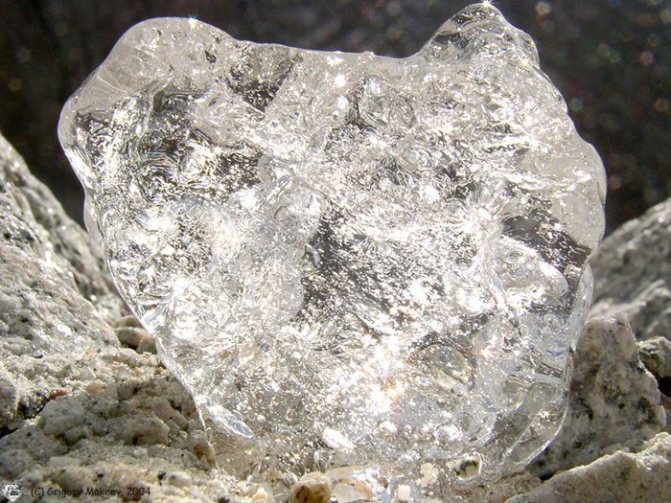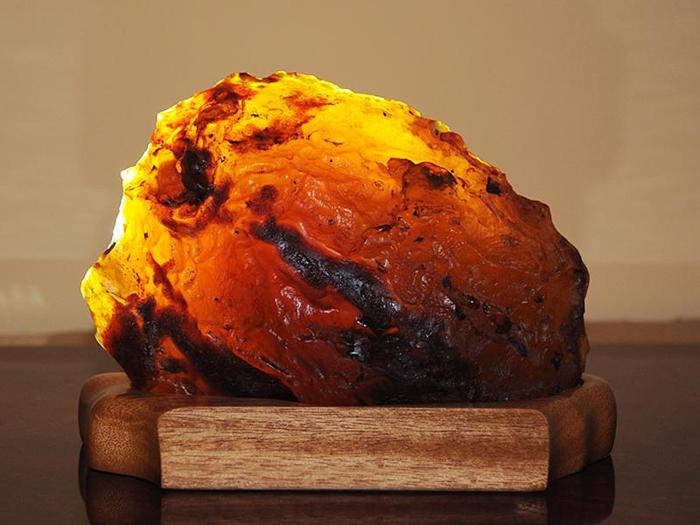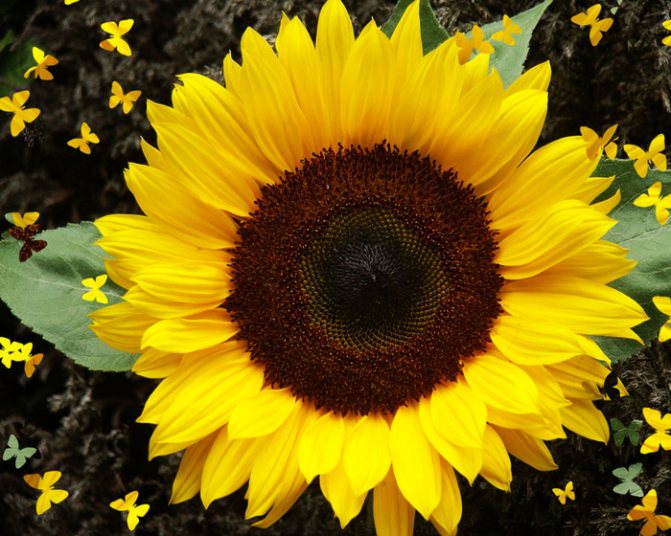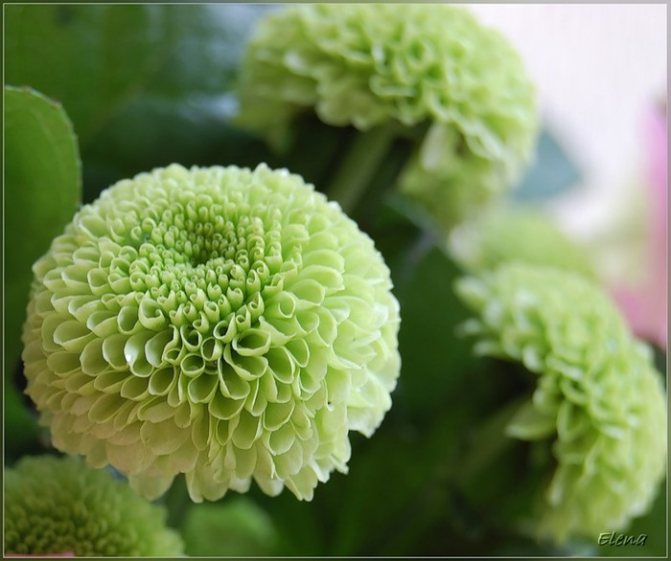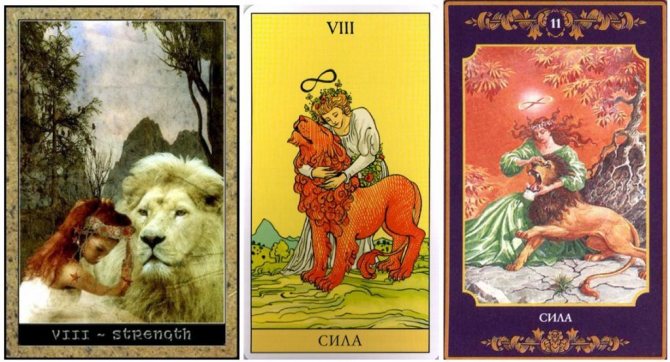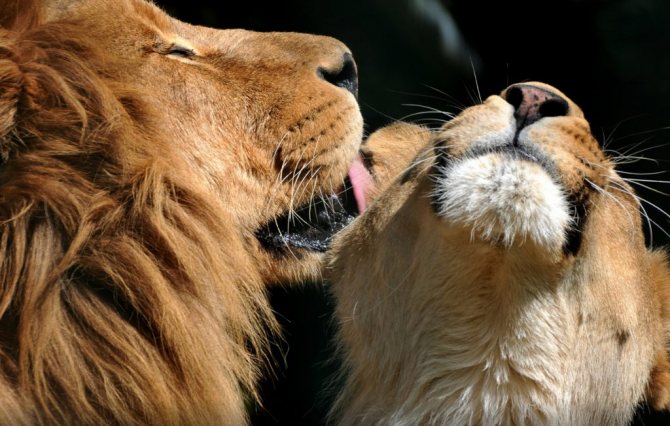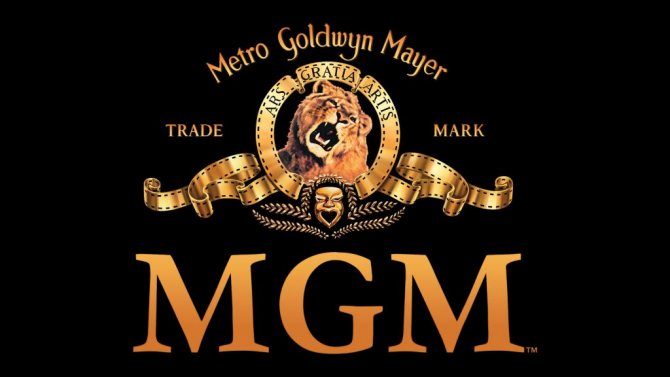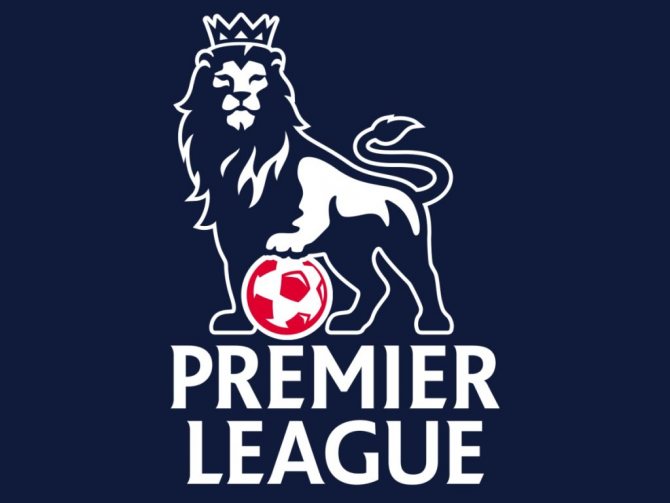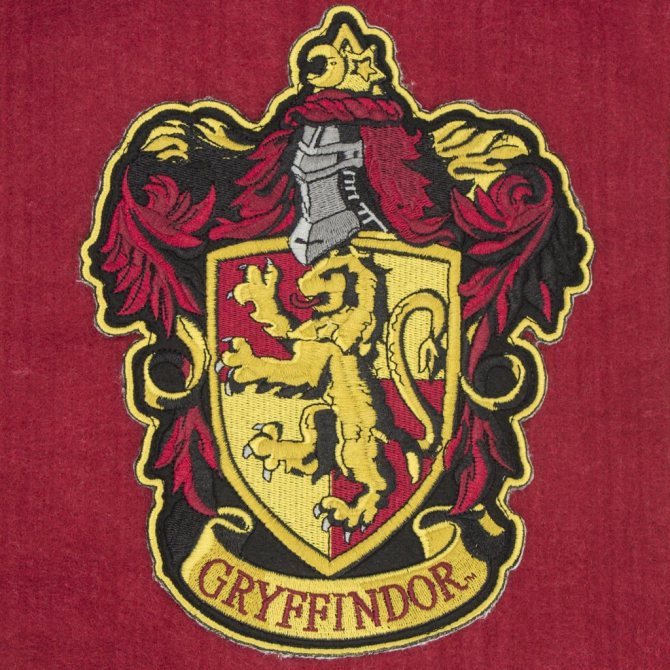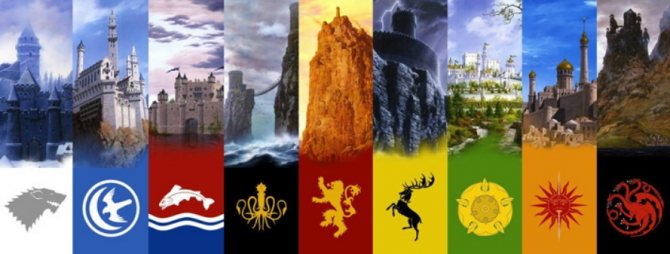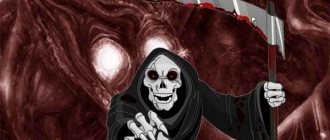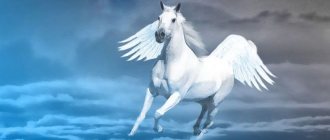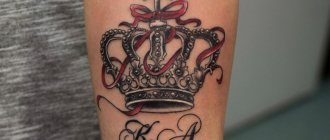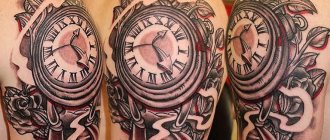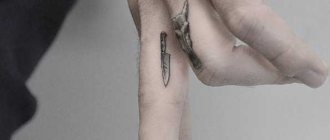Since early antiquity, the lion has occupied a crucial place in the rituals and belief systems of various societies. The ancient Egyptians pictured the lioness as the goddess of war, Sekhmet. Later, the lion became a symbol of the god Osiris, who was the judge of the dead. In the Lower Egyptian city of Leont-Paul the lion-god Micha and his two lion cubs, Shu and Tefnut, were worshipped. The two-headed lion represented the solar gods of dawn and sunset, and the two lions standing with their backs to each other represented the past and the present.
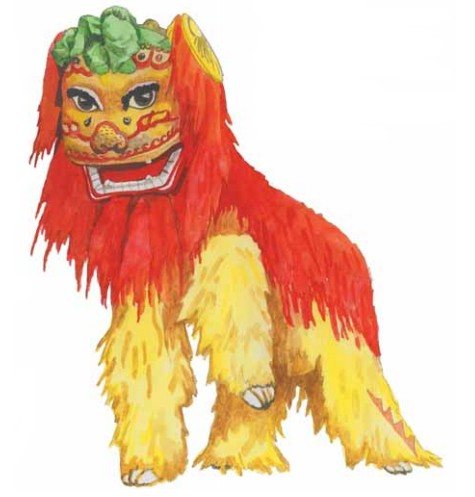
Dancing Lion. The Chinese lion dance is associated with the ancient beliefs of the Han Chinese, who wished on New Year's Eve to banish evil spirits and bring happiness to their homes. In Buddhism, the lion symbolizes law, wisdom, spiritual zeal, and the apprehension of truth.
In ancient times, lions were protective symbols, correlated with one of the four sides of the world. When you look at the symbolic meaning of lions, you must know that lions are seen as a symbol of wisdom, wisdom, spiritual zeal, or truth, and they are the symbols of the four corners of the earth. Indo-Europeans used lion statues as guards of city gates. A pair of lions symbolizes a ruler with dual power and authority. Also a lion is the guardian of treasures and the tree of pestilence.
In alchemical symbolism the lion plays a major role, denoting sulfur and philosophical mercury.
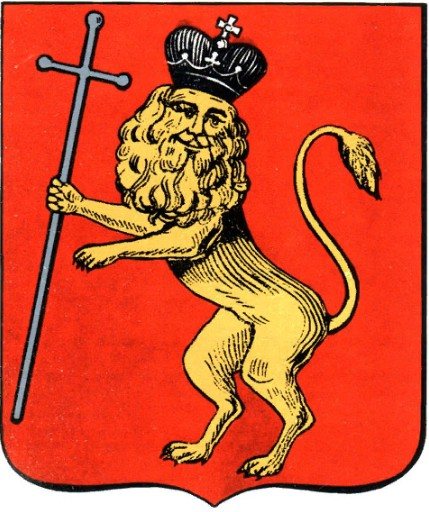

Lion on the coat of arms of the city of Vladimir - the generic sign of the dynasty of Vladimir and Suzdal princes
The constellation and zodiacal sign of Leo
The largest star in the constellation of the lion is Regulus, which translates from Latin as "royal." In ancient Egypt, this constellation rose in the zenith at the beginning of spring, opening the "dead season", when the desert was in the power of the lions and no man was allowed to enter there. The Egyptians believed that under the sign of this constellation great rulers were born.
The ancient Greeks believed that this constellation was the Nemean lion, the offspring of Typhon and Echidna, whom Heracles defeated. In ancient times, the ritual duel between the king and the animal was part of the coronation ritual not only in Greece but also in Asia Minor and the Middle East. The new ruler, having won, was given power over the time of the year during which he reigned. In this case we are talking about spring and early summer. European tradition ascribes to the zodiac sign of Leo such qualities as belligerence, power, vanity, nobility, natural authority and greatness of spirit.


The zodiac sign of Leo. Fresco by F. del Cossa in Palazzo Sciphanoia, Ferrara, XV century.
Where else to hang a painting of a lion according to feng shui?
First we must decide in what pose the mighty guard is depicted.
Leaping or crouching lion
An image of a lion hopping or crouching according to feng shui symbolizes good luck. A good place for it would be the office. In this case, it is desirable that the king of beasts was well lit by sunlight - he is able to accumulate the energy of the daylight, turning it into the power of creation.
A lion on a pedestal
A lion depicted on some elevated position or pedestal denotes leadership. Such an amulet would be suitable for a person who wants to manage other people, a leader. But there is a nuance here: if such a person already tends to authoritarianism, a talisman could turn him into a true dictator and autocrat. For a similar reason, the picture "lion" according to feng shui is not suitable for all women. Those persons who are distinguished by an excessive power, it is better to refrain from such decorations in your interior.
The Lion of St. Mark
In Christianity, the lion is the emblem of St. Mark, because his Gospel emphasizes the royal majesty of Christ. This saint is considered the patron saint of Venice, so the winged lion became the emblem of the city. In ancient times, it was believed that the lion slept with his eyes open and that lion cubs were born dead and came to life after their father breathed life into them. As a consequence, the lion also symbolized vigilance, spiritual strength and resurrection. The lion is the guardian of the foundations of the church.
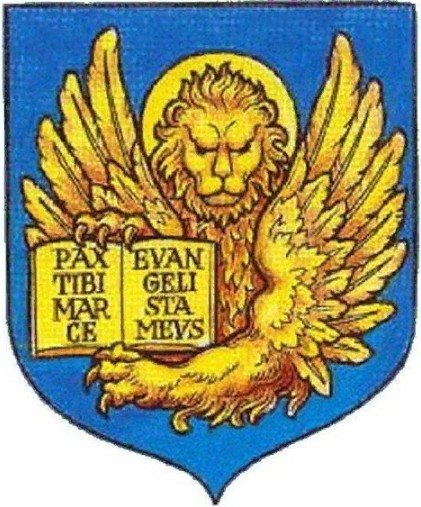

The coat of arms of Venice
Saint Mark. Miniature from the "Sumptuous Book of Hours of the Duke of Berry", XV c.
The lion as a symbol - what it means, and where did it come from in the peasant's painting
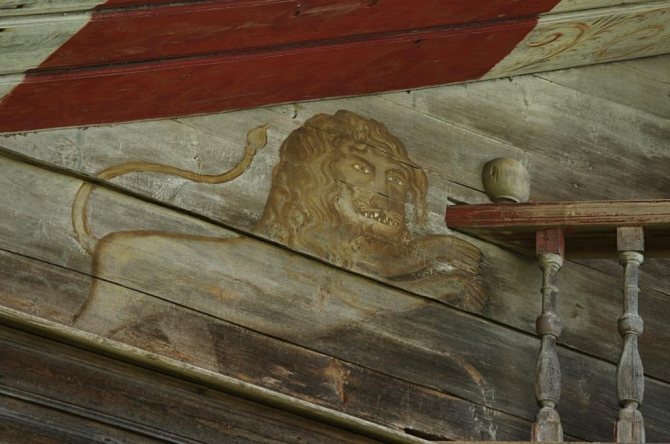

In my photographs taken during trips to the Russian North, this specimen of predatory mammals belonging to the subfamily of large cats, a representative of the panther genus named "Panthera Leo" is often seen. One might get the misleading impression that lions were painted in all the back corners of Arkhangelsk and Vologda provinces, but this is not true. Or rather not exactly so - the Russian peasant loved lions and in regions where there was a fashion for house paintings, often depicted them.
But this fashion was very spotty on the map of Northern Russia - in one district you can't find lion paintings, in another district there is something or other painted on the pediment of a house. To find a lion which was painted over 100 years ago by an unknown house painter is great luck and that is why I look for such "exotic" plots in my travels.
But why is it that the lion is so beloved by the Russian man! It is impossible to give a clear answer now, but with a bit of brainwork we can try to understand the peasant's thinking and give an answer - this animal was exotic (no one ever drew dogs, wolves, cats, elks and all sorts of wild boars), but at the same time it was both "fierce" and a loyal assistant of various biblical characters in one person. By painting or ordering a painter to paint a lion, the owner of the house as if placed guards on it. Of course, drawings would not protect from robbers or thieves, but when faced with the choice of plot a person chose the most obvious and acceptable for the occasion.


It is much more interesting to understand, from where did the folk artists adopt this image? The answer is not so complicated - from heraldry; the sticking out of the tongue is necessarily indicative of that. But by heraldic lion one must understand a large number of sources - these include the British coat of arms, the cast-iron lions of St. Petersburg and cheapskate pictures.... It is the symbolism of the lion that I will talk about today. The material will be boring - heaps of quotes, alien phrases and references.
Before the beginning of this excursion I would like to make a grounded statement - there were no lions on the territory of Russia in the foreseeable past! For some people this statement might seem obvious and ridiculous, but I regularly receive letters from people who assure me that these little animals were drawn from nature, and lions apparently lived everywhere among the Russian people not so long ago, because the climate was different. Of course, those who say such things have mental deviations, but there are surprisingly many of them!
So, to close this question forever, I will make a small excursion into the history of decoration of Slavic houses: windows with glass in the houses of commoners appeared only at the turn of the 18th-19th centuries - window glass was very expensive, and even in the 18th century was almost exclusively imported. The first glass factory in our country was opened in 1635 by the Swede Elisey Coyet "... the cannon and ore craftsman Elisey Coyet was granted, in our Moscow State they ordered to make glassware". This factory produced only vials for the Pharmacy order and utensils.
In the mid-18th century, there was literally an industrial explosion in the Russian economy - factories and factories appeared like mushrooms after the rain, built, of course, and glass works, so in 1804 there were already 114. But only a few made window glass - the technology was complicated and the products were expensive. The peasants who were richer could afford to make only one small squint window per house and glaze it, the remaining windows were drag windows.
White stoves appeared around the same period - early 19th century, so the likelihood that someone depicted lions or flowers in the dark and smoky huts is zero. In addition, they can only be painted on a flat surface - a board, but sawn board also became available as a result of the industrial revolution - the mid-19th century. That is when - in the 1850s - such a beautiful decoration of Russian houses as platbands with propylated carving was born.
But the carving of the Volga region - "deaf" or "ship" is older - the oldest known example dates back to 1814. This suggests the right conclusion - the house painting of peasant houses could not have arisen earlier than the mid-19th century. That is, steamships and steam locomotives were already running, newspapers were being published, revolutionaries from "Land and Will" were already seducing the commoners..... It is difficult to imagine that saber-toothed tigers and cave lions were running around.
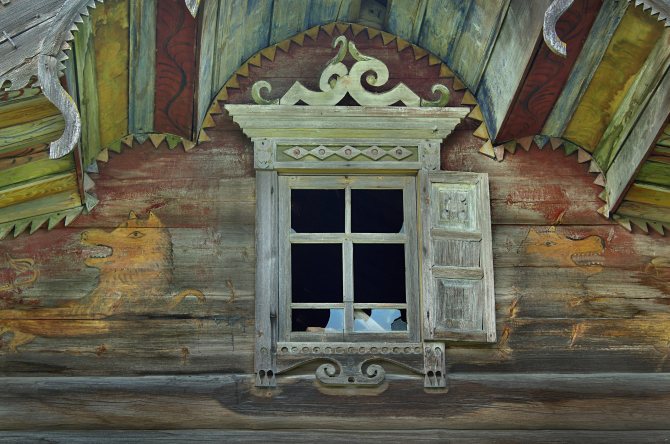

Russian society before the Revolution was very religious, so people drew their knowledge about the world solely from sacred books. It is fair to say that for centuries in Russia they read nothing but the Bible, so the universe of the Russian peasant fit perfectly into the paradigm of Christianity-all weather phenomena, famines and epidemics, lions and leviathans, fairies and house-dwellers, moral dogmas and sins, class stratification and syphilis-all these are components of the Christian's habitual world. From here we will dance.
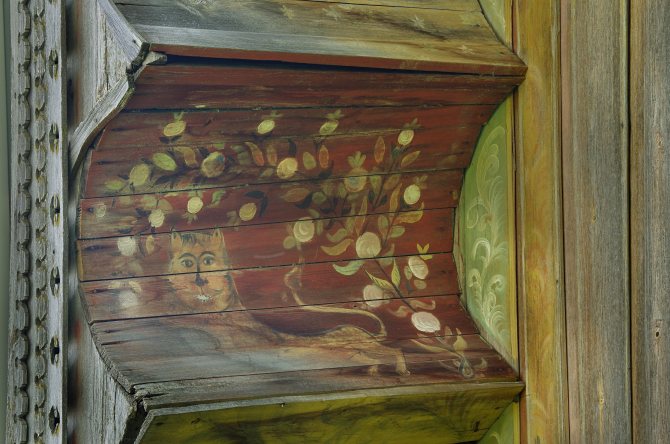

"The lion is a wild and predatory animal, well known to all, and therefore requiring no special detailed description. The lion's exterior is majestic, its fluttering mane, bristly eyebrows, glistening teeth, and daring appearance truly present a striking sight. The lion is sometimes more than 8 (English) feet long and over 4 feet tall. The skin color of lions is mostly red-brown. Their courage and fearlessness have become a proverb.
These predatory animals were once found on the marshy banks of the Jordan, but because of the annual overflow of the river they abandoned them and became even more ferocious and courageous (Jer.49:19). Allegorical references to the quality and properties of lions, these, in fact, kings of beasts, in the Bible are very numerous, and they are so clear that they do not require special explanation.
The Scriptures often mention, for example, his terrible roaring, sharp teeth, fierce eyes, daring attacks for prey, and the swift leaps with which he lunges at it. The Jews, who were so familiar with this noble animal, had various names for it according to its age and sex, such as: young lion cub, old lion, lioness, etc. (Deuteronomy 33:22, Ezekiel 19:2, Psalm 33:11, Hosea 5:14, Numbers 23:24, etc.). Samson (Judges 14:5,6) and David (1 Samuel 17:34,37) had happy struggles with lions. The prophet of Judah was mauled by a lion as he returned home from Bethel (3 Samuel 13:24,26). Daniel was saved from the lions, into whose moat he was thrown (Dan. ch. 6).
Lions in sacred Scripture are symbols of people, characterized by particular strength, power and might (Dan.7:4). The roaring of a lion is likened to the word of God (Iov.4:10,11), which is always a stunning effect on the hearts of men (Am.3:4,8). The roaring lion, seeking to devour man, is likened to the devil, who seeks the destruction of man (1 Peter 5:8).
The book of Job speaks of the lion in the following words: "The roar of the lion and the voice of the roaring lion are silenced, and the teeth of the skimmer are crushed; the mighty lion perishes without prey, and the children of the lioness are scattered.
And in the book of Pr. Nahum contains another relief, allegorical depiction of the age, appearance, and ferocity of the lions, namely: "Where now is the lions' den, he says, and that pasture for lion cubs, where the lion and the lioness and the lion cub walked, and no one frightened them, the lion stealing to feed his cubs, and smothering for his lionesses, and filling his caves and his lairs with prey to be stolen?" (Nahum.2:11).
All the poets of antiquity have made references to the noble courage and strength of the king of the four-footed, and not a few of them are also found in sacred Scripture. Images of lions are often found in the Assyrian and Babylonian statues, and on the monuments of the Egyptians, who, as we know, worshiped lions. Nowadays lions are rarely seen in Syria, but they are often seen in Chaldea. They were and are often seen also along the rivers Euphrates and Tigris. The old lion of western Asia has a black mane, and hence his nickname is probably Shachal, i.e., black lion." (Bible. The Old and New Testaments. Synodical Translation. The Encyclopedia of the Bible...arch. nikiphor. 1891).
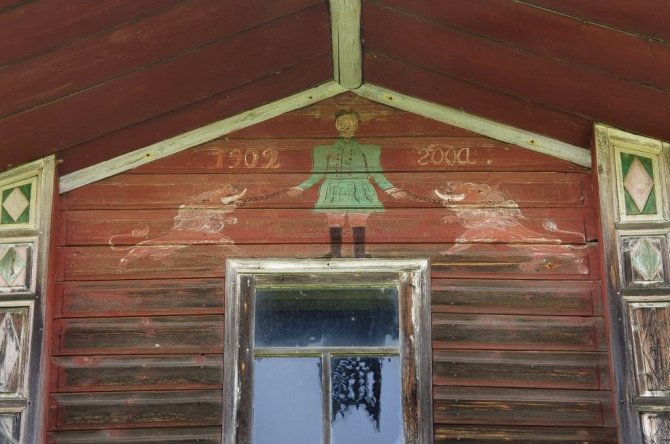

In ancient Russian literature there are practically no descriptions of this large cat, except that Damascene Studit in his work "Collected from the ancient philosophers on certain natures of animals" gives a rather detailed description: "The lion is the king of all quadrupeds, as the eagle of all flying ones. He has a great chest, his knees are strong, his legs are firm, and his eyes are regal and fearful. His hair is thick, his mouth is wide, his ribs are strong, his hips are thick, his legs are great, his gait is proud, his neck is thick. His bones have neither hollow nor brain, as other animals have... When he runs to catch an animal, he does not bow his head, but holds it high, like an invincible king... He eats much, but he drinks little."
The image of the powerful beast was emphasized by some details: "when enraged, strikes his ribs with his tail," "loves honor, the beasts fallen before him to the ground do not bruise." Separately, much attention was paid to the powerful roar of the predator, so powerful that with its help it can stun its prey: "The lion with its strong and terrible voice immobilizes beasts that he cannot reach from afar" and "For they say that lions rest in their lairs on the mountains, and they hide, so that with their stealth they may terrorize other animals that they feed on. When the lion sees some (animal) that has come close, and quickly jumping up, growls loudly, and, unbearably stunning it, attacks and grabs the lion (prey), first relaxing its veins with fear" (interpretation of Cyril of Alexandria). In his old age, however, he makes an attempt at rejuvenation by eating another animal: "But when he is sick, and comes to death, he has no remedy, as if only to eat a monkey. Therefore, when he is sick, roars, and all the animals gather in his den, then the monkey comes too, and he desires no other animal, but only grabs the monkey and eats it."
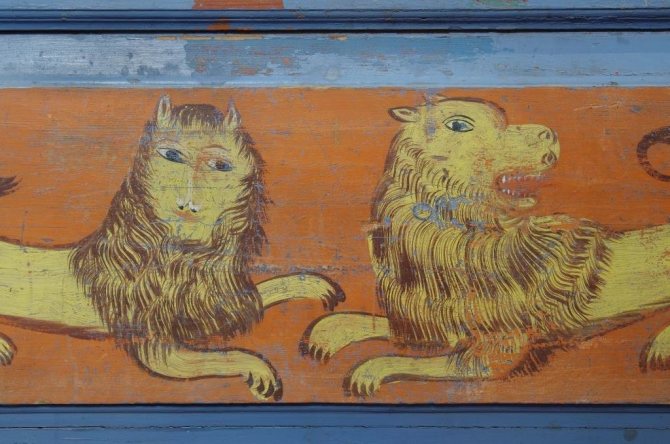

In the various "physiologies," where every animal was perceived also from a religious and dogmatic point of view, often the lion as king of beasts was presented as a type of Christ, the King of Peace. In confirmation of this, the properties of the animal were cited to liken it to Christ.
So the first characteristic attributed to the lion is the reanimation of his young: "When the lioness gives birth to a cub, she gives birth to it dead and keeps it for three days until its father comes and blows on its face and it comes to life", it is worth noting that three days pass between the birth of the cub and its revival, exactly as long as Christ was dead ("Thus God Almighty, the Father of all, on the third day raised up his firstborn son and 'born before all creation'").
In the Byzantine version, the lioness gives birth not only to a dead, but also to a blind kitten, and the emphasis in the interpretation is on blindness, where the cub is compared to a pagan not yet sanctified by the sacrament of Baptism ("Also of faithful nations, for before baptism they are dead, but after baptism they receive sight from the Holy Spirit").
In later versions, the theme of the resurrection of the cubs disappears, and the lioness gives birth to the lion herself, who lies breathless for three days, in order to then rise and "begin to reign over all the beasts of the earth." The parallels with Christ and the Virgin Mary are even more obvious here - "The lioness is the Blessed Virgin Mary, and the lion is Christ, who died in the grave three days and three nights in the flesh, and did not reign in the Godhead, descended into the underworld, and shattered the eternal faiths, and rose on the third day, and reigned over all the saints".
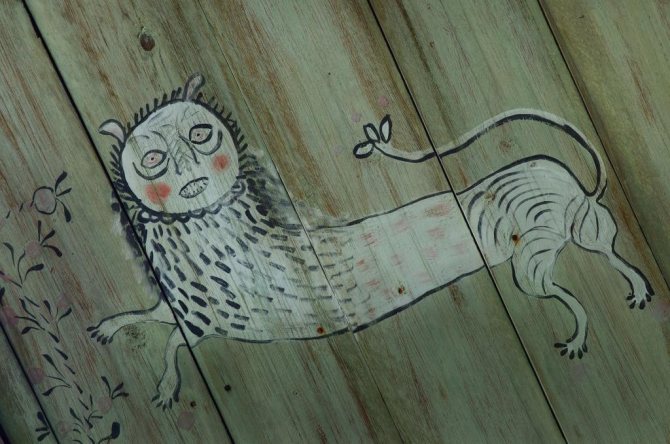

The second characteristic attributed to the lion was that he supposedly sleeps with his eyes open: "When the lion sleeps in his cave, his eyes are awake, for his eyelids are up, as Solomon testifies in the Song of Songs, saying, 'I sleep, but my heart is awake. For my Lord died as flesh on the cross, but his Deity at the right hand of the Father was awake." A simpler treatment of this dormant sleep was given in "On the Savior's Unsleeping Ocean": "The lion sleeps with one eye, and looks with the other. So also Christ, sleeping in the tomb in the flesh, saw everything as God."
The third characteristic of the lion that connects him with the Son of God is the belief that Panthera leo covers his tracks with his tail when trying to hide from pursuit - "When he goes up the mountain, though he catches prey, and he smells a man, his tail covers his tracks, so that those who follow him will not find his trail and will not catch him." In the same way, Jesus hid his divine nature during his human incarnation. But there was certainly no cowardice in fleeing from the hunters - "And he covers his tracks with his tail, lest they hunt him down. But when they leave him, he returns to them without fear, and fights them a lot because of the strength he has.
But in parallel with this, in Old Russian Orthodox tradition and iconography, the image of the lion is closely related to the images of the Devil and dying, so it is not uncommon to see the king of beasts in the form of "looking for whom to devour" death on an icon.
Describing death, the Tale of the Dispute of Life and Death compares it as having "a terrible appearance, like a roaring lion. And among the temptations of all kinds of saints there is necessarily a lion (both the predator himself, and often a demon who has taken on his appearance).
The lion (along with the eagle and the calf) became very popular in iconography thanks to the vision of the prophet Ezekiel. The prophet described in it an incredible creature with four faces - a man, an eagle, a lion and a calf. These same animals were mentioned in the Apocalypse by John the Theologian. Initially Ezekiel's vision was interpreted as the essence of Christ, where each part represented some essence: the man the incarnation, the calf the sacrifice, the lion the victory over death, the eagle the ascension. Later it became customary to correlate animals with the evangelists. Thus the lion came to represent Mark.
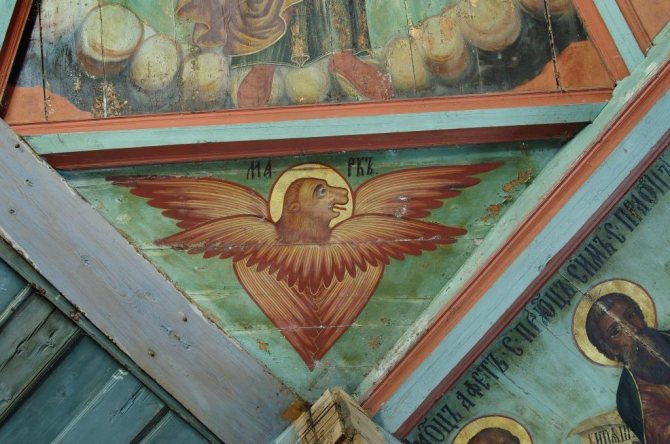

Of course, other religions did not avoid the lion, for example, in ancient Egypt, the goddess of war and scorching sun Sekhmet was depicted as a lioness, and the lion itself was a guide to the afterlife. In ancient Greece, lions were also considered the guardians of death, and victory over them was understood as the triumph of life. In India, our hero is one of the incarnations of Vishnu, in Mongolia, China and Japan lion is the protector of the good.
The lion and its variety, the leopard, occupy a special place in heraldry. According to Laker, the lion is a symbol of strength, courage and generosity, while the leopard is a symbol of courage and bravery. If anyone is interested, it is easy to find all varieties of heraldic lions, but in brief we can say the following:
- an animal depicted in profile standing on its two hind legs is actually a lion.
- A lion marching, touching the ground with three paws and facing in profile is a leopard lion.
- A leopard marching with one paw raised, but facing in full-face is a leopard.
- standing on two hind legs facing in full-face - a lion's leopard.
And there must be a tongue sticking out, because a mouth without a visible tongue is a symbol of a humiliated, defeated lion.
And as an appetizer, a symbolism in alchemy: the green lion stands for a universal solvent (a mixture of hydrochloric and nitric acids). In some alchemical treatises, lead oxide or massicote was also designated in the same way. And in the book "Rosary of Philosophers" lion is called "our mercury", i.e. the very material of which all known metals are composed. As the lion in medieval bestiaries is chief among the beasts, so primordial matter is the main substance in the world of metals. In the story of the treatise, gold tries to challenge the primacy of mercury, which replies: "But after all, I conceived you, and you were born from me."
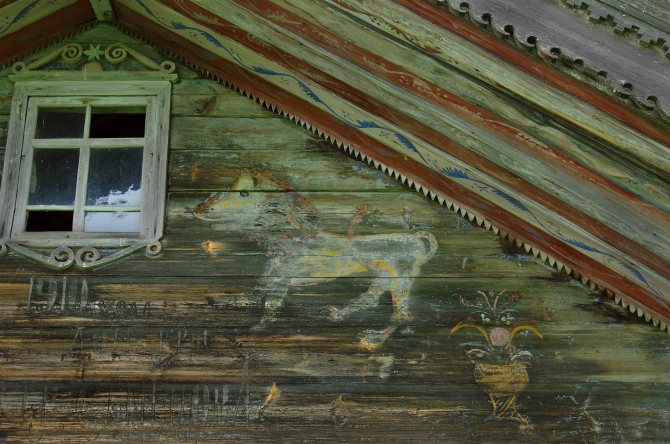

The text and photos by Nikolai Telegin. (The greater part of the material is taken from the article by N.V.Butskikh "The Symbolism of the Lion in Old Russian Art")
The winners of lions
The symbol of lion as the embodiment of power is closely connected with the mythological motif of the hero's victory over this formidable animal. The Old Testament judge, i.e. ruler Samson, kills the lion with his bare hands. The future Hebrew king David also fought a lion.
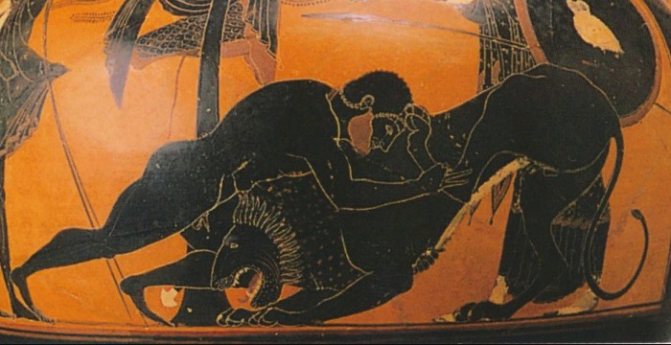

Hercules kills the Nemean lion. Fragment from an ancient Greek vase
The same feat is performed by Hercules when he kills the Nemean lion. Some scholars believe that the hero's victory over the lion symbolizes the transfer of royal power from the old ruler to the new one.
Nutrition
Lions are carnivores; their diet is based on meat alone. In the wild, animals hunt collectively at night, occasionally during the day. Roles are clearly distributed. The male scares his prey with a terrifying roar, while fast and agile females rapidly pounce on their victims. The surprise factor is very important, because lions can run fast only for short distances.
White lions are much harder to hunt because of their lack of camouflage color. Solitary hunting of young males wandering without a pride can occur. The efficiency of such hunting is only 17% in contrast to 30% of collective hunting. The daily requirement of each lion is 7-8 kg of meat. In Africa, buffalo, Thomson's gazelle, warthog, zebra and gnu antelope fall prey to predators.
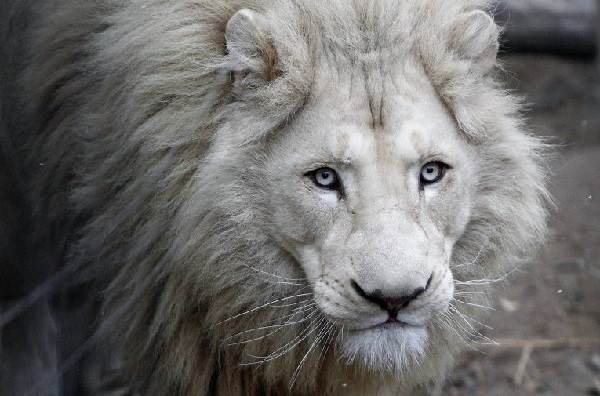

A hungry white lion on the hunt
Lucky and tough lions can handle an adult giraffe, a hippo, an elephant. The animals do not give up their fallen animals and livestock; they take prey from other predators that are inferior in size to lions.
Lions, unable for various reasons to capture large prey, eat rodents, birds, reptiles, pick up ostrich eggs, finish off hyenas and vultures. A lion can eat from 18 to 30 kilograms of meat at a time. The next days they can do without food for up to 3-14 days. The diet in zoos is not as varied as in the wild. Most lions are fed with beef.
The Lion of Jerusalem
According to the Hebrew calendar, the sign of the zodiac Lev is a symbol of the month of Aghv, which falls in July and August. The lion is also considered the emblem of the tribe of Judah, from which the kings of the ancient Jews came, and to which Jesus Christ belonged. Followers of Judaism believe that from this tribe also comes the expected future messiah. The lion of Judah is the solar sign that is to destroy the troubles and suffering of the people of Israel. According to Talmud prophecy, on the day when the Messiah comes, God will take the sun out of its "cover," and it will burn all the wicked and bring healing to the righteous. The lion is located on the shield of the coat of arms of Jerusalem against the background of the image of the Wailing Wall. The olive branches bordering the coat of arms symbolize peace and tranquility.
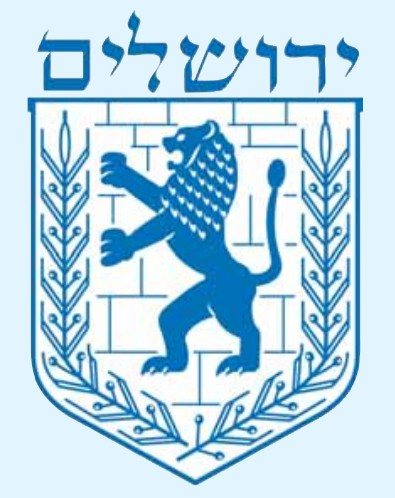

Coat of Arms of Jerusalem
Share link
Origins.
Totems are the ancient ancestors of coats of arms
The invention and use of various signs and symbols is peculiar to man. The custom of choosing a special distinctive sign for themselves or for their family and tribe has very deep roots and is widespread throughout the world.
Clan signs and symbols are called totems; they are the closest relatives of coats of arms. The word "totem" comes from North America, and in the Native American language the word "ototem" means the concept of "his kin. The custom of creating a totem is for the clan or tribe to choose an animal or plant as a progenitor and patron from whom all members of the tribe trace their ancestry.
The ancestors of coats of arms - various symbolic images - have been used since antiquity. Both legendary heroes and real historical figures often had personal emblems. Thus, the helmet of Alexander the Great decorated the sea horse, the helmet of Achilles - the eagle. Shields were also decorated with a variety of emblems.
So, insignia and emblems have always existed everywhere. But heraldry emerged during the feudal system in Western Europe.
Crusades.
While everyone lived in their own domains, there was no serious need for distinctions.
But now everything changed.
1000 years ago the Pope gathered knights and made a campaign to the south of Asia to spread Christianity in the East. Often the knights who participated in the crusades spent entire days wearing helmets and armor. In such a large number of armed men it was almost impossible to recognize each other. In order to facilitate this task, they began to use symbols - personal identification signs of soldiers. The warriors who returned from Palestine kept them sacred and passed them on as heirs. In a few decades, these identifying marks became symbols of their families and clans.
Heralds
There were many knights on the campaign, sometimes more than a hundred thousand. It became necessary to memorize all coats of arms and establish rules for their use. The compilation of these rules was entrusted to veterans of the campaign known for their valor.
Heer-alt, herald, heraldmeister (from the German word "old master", "veteran") - a person who develops the general principles and rules of coats of arms.
